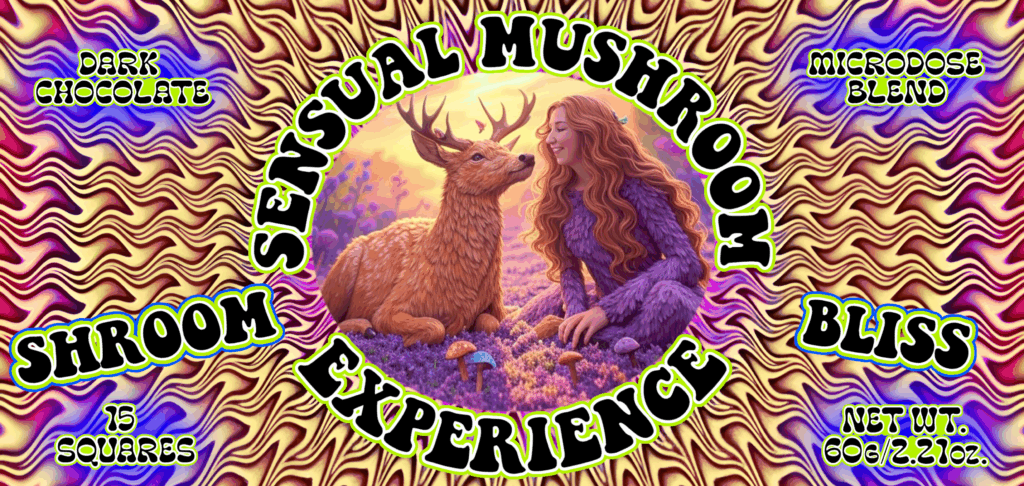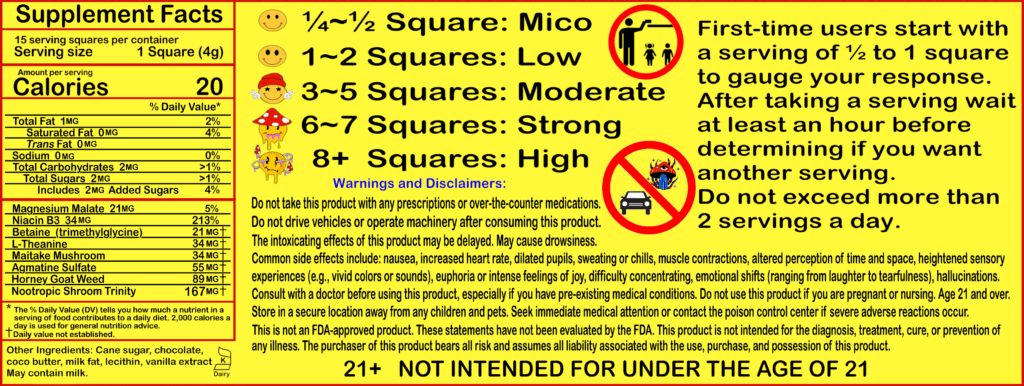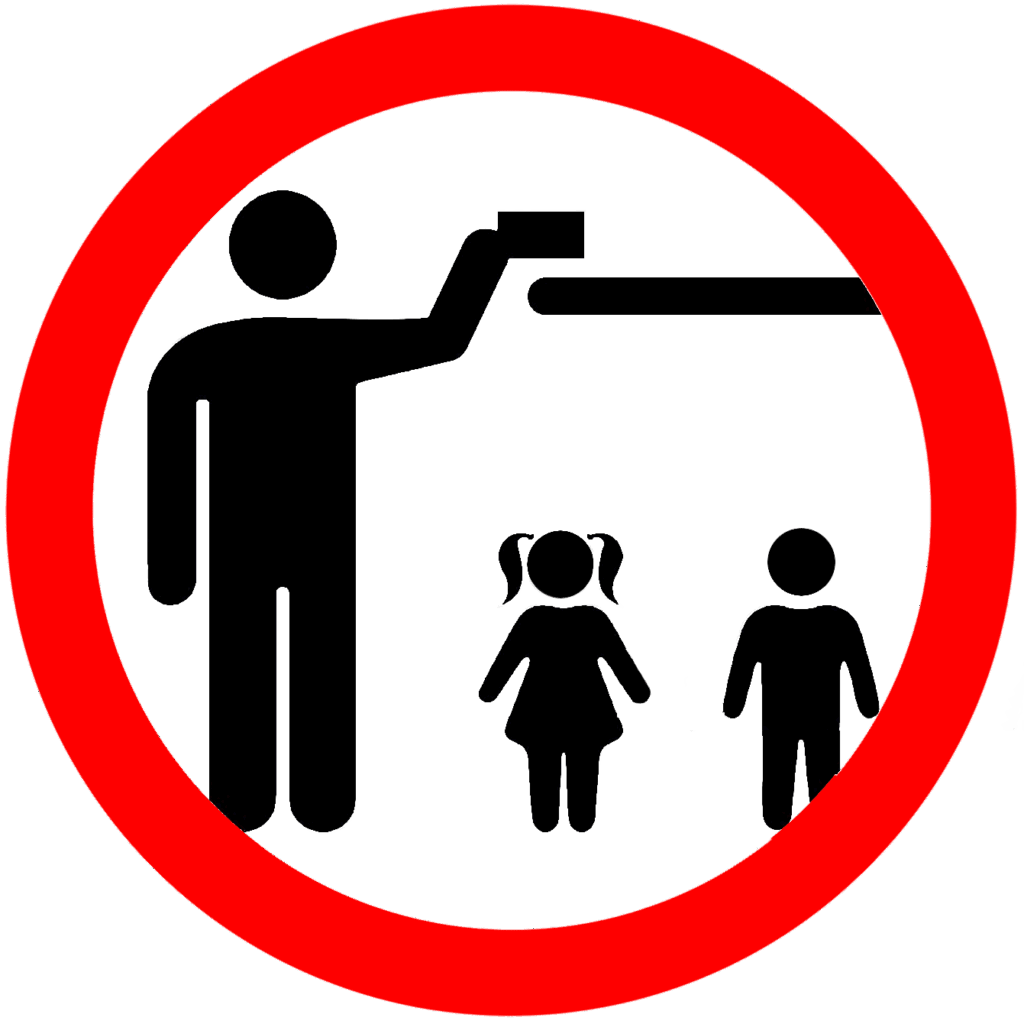


Shroom-Bliss Magic Mushroom Chocolate Bar:
- Shroom Bliss is often described as a blend of psilocybin-like depth with a more manageable headspace, visually intense, with a unique emotional and sensory profile, leaning toward introspection and tactile enhancement.
- Shroom Bliss does not contain psilocybin or amanita muscaria.
Ingredients:
- Magnesium Malate, reported to dampen muscle fasciculations related to psilocybin experiences.
- Niacin B3, part of the Paul Stamets stack.
- Betaine (trimethylglycine) methyl donor to help the liver process the high dose of niacin.
- L-theanine is an amino acid found primarily in green and black tea and some mushroom. It’s said to help ease anxiety, stress, and reduce insomnia. Reported to help managing anxiety related to psilocybin experiences.
- Maitake Mushroom, known as hen-of-the-woods or dancing mushroom. Might help fight tumors, stimulate the immune system, reduce blood pressure and lower blood sugar levels.
- Agmatine Sulfate, made from the amino acid called arginine. May improve blood flow, enhance nitric oxide production. Different studies saying benefits for cognitive health, pain relief.
- Horney Goat weed, used in traditional Chinese medicine. It is claimed to be a natural aphrodisiac.
- Nootropic Shroom Trinity, proprietary of course, legal currently. The full bar is equal to about 2.5 grams, that’s on the very high end of what is currently in the common magic mushroom chocolate bars out there, tested many of them.
Other Ingredients: It’s Ghirardelli Dark Chocolate, very delicious.
Warnings and Disclaimers
- Shroom Bliss may cause psychotropic effects. Shroom Bliss is not intended for use by those under the age of 21.
- Do not use this product unless recommended by your doctor.
- Do not use more of this product than recommended by your doctor.
- Do not use this product if you are pregnant, nursing, or under 21 years of age.
- Do not use this product if you have any diagnosed or undiagnosed health conditions.
- Make sure your Shroom Bliss Chocolate Bar is locked in a secure location so children cannot access it.

- Do not drive or operate machinery while using Shroom Bliss

Duration and Dosage
- Onset: 15–30 minutes.
- Come-Up: 30–40 minutes.
- Peak: 1–3 hours.
- Come-Down: 2–4 hours.
- Total Duration: 4–6 hours, with residual effects possible.
Harm Reduction Tips
- Start with a low dose to assess sensitivity.
- Avoid mixing with other substances, especially alcohol, stimulants, or antidepressants.
- Use in a calm, familiar setting with trusted people.
- Listen to calming, lyric-free music (e.g., classical, ambient, or Johns Hopkins psilocybin playlist) to enhance the experience.
- Stay hydrated and consider light snacks to manage nausea.
- Have a sober trip-sitter for higher doses.
Risks and Side Effects
- Psychological Distress: High doses or unsuitable settings can lead to anxiety, paranoia, or confusion.
- Hallucinogen Persisting Perception Disorder (HPPD): Rare, but persistent visual disturbances or flashbacks may occur.
- Drug Interactions: Combining with alcohol, stimulants, SSRIs, MAOIs, lithium, or tramadol can cause adverse effects like serotonin syndrome, seizures, or heart issues.
- Physical Risks: Mild cardiovascular effects (e.g., increased heart rate) and nausea/vomiting are possible.
- Long-Term Effects: Chronic use may lead to tolerance, dependence, or mental health impacts.
Physical Effects
- Stimulation and Body High: Users often experience a warm, pleasurable, tingling sensation throughout the body, which can feel all-encompassing and euphoric. It’s primarily stimulating but can also have relaxing or sedating qualities at higher doses.
- Nausea: Some users report mild to moderate nausea, especially during the come-up, which can be mitigated by taking it on an empty stomach or with ginger.
- Temperature Dysregulation: Fluctuations in perceived body temperature, leading to feelings of warmth or coldness.
- Tactile Enhancement: Heightened sensitivity to touch, often reported as pleasurable or erotic, making physical sensations like textures or massages more intense.
- Muscle Contractions: Transient, benign muscle contractions may occur, less intense than with other psychedelics.
- Dilated Pupils: A common physiological response, often accompanied by mild increases in heart rate and blood pressure.
- Excessive Yawning: A pronounced effect, similar to psilocin, often paired with watery eyes.
- Motor Impairment: Higher doses may cause slight coordination difficulties, or a heavy, relaxed body feel.
Visual Effects
- Enhanced Colors and Patterns: Vivid, bright colors and intricate patterns are common, with visuals often described as more intense than psilocybin but less “organic.” Objects may appear to “breathe” or morph.
- Closed-Eye Visuals: Complex, colorful geometric patterns, fractals, or organic landscapes are frequently reported, sometimes more vivid than open-eye visuals.
- Distortions: Time dilation, flowing edges, and perceptual changes like synesthesia (e.g., “seeing” sounds) can occur, especially at higher doses.
- Visual Geometry: Visuals are similar to psilocin or ayahuasca, with intricate, algorithmic patterns that feel warm and natural.
- Tracers and Afterimages: Moving objects may leave trails or lingering images, more pronounced at higher doses.
Cognitive Effects
- Euphoria and Mood Enhancement: Users often report heightened mood, elation, and a child-like curiosity, with a sense of freedom and life affirmation, profound personal insights or emotional processing, though less intense than psilocybin.
- Euphoria and Mood Lift: A strong sense of emotional warmth, joy, and connectedness is common, often described as more uplifting than psilocybin.
- Clear-Headedness with Depth: Headspace remains relatively clear compared to psilocybin, allowing for introspection without overwhelming confusion.
- Analysis Enhancement: Enhanced introspection and problem-solving, particularly at lower doses, with a focus on external perspectives.
- Impaired Communication: Higher doses can make expressing thoughts difficult, despite relatively clear thinking, and may cause confusion in social settings.
- Synaesthesia: Possible at higher doses, where senses blend (e.g., visualizing music or tasting colors), especially in those predisposed.
- Anxiety or Paranoia: Mild anxiety may occur during the come-up, particularly in unfamiliar settings, but is less common than with other psychedelics.
Emotional Effects
- Empathy and Connectedness: Strong feelings of emotional openness, empathy, and connection to others or nature, similar to psilocybin but with a unique warmth.
- Emotional Amplification: Both positive and negative emotions can be intensified, leading to cathartic experiences or, rarely, discomfort if in a poor mindset.
- Spiritual or Mystical Experiences: Some users report profound spiritual insights or feelings of unity, though these are less consistent than with psilocybin
- Potential for Bad Trips: While rare, negative emotional states like anxiety, paranoia, or confusion can occur, especially at higher doses or in poor settings. Responsible use (e.g., calm environment, trusted company) minimizes this risk.
Therapeutic Potential
- Similar to psilocybin, may have potential for treating depression, PTSD, anxiety/stress reduction, or addiction (e.g., tobacco cessation), with effects like enhanced neuroplasticity and emotional processing. Anecdotal reports suggest benefits lasting days to weeks
- Microdosing may improve mood, promote positive habits like meditation or exercise, creativity, and focus, though formal research is lacking.
- Introspective and empathetic qualities make it promising for psychotherapy-like settings, but it requires a controlled environment, though research is limited.